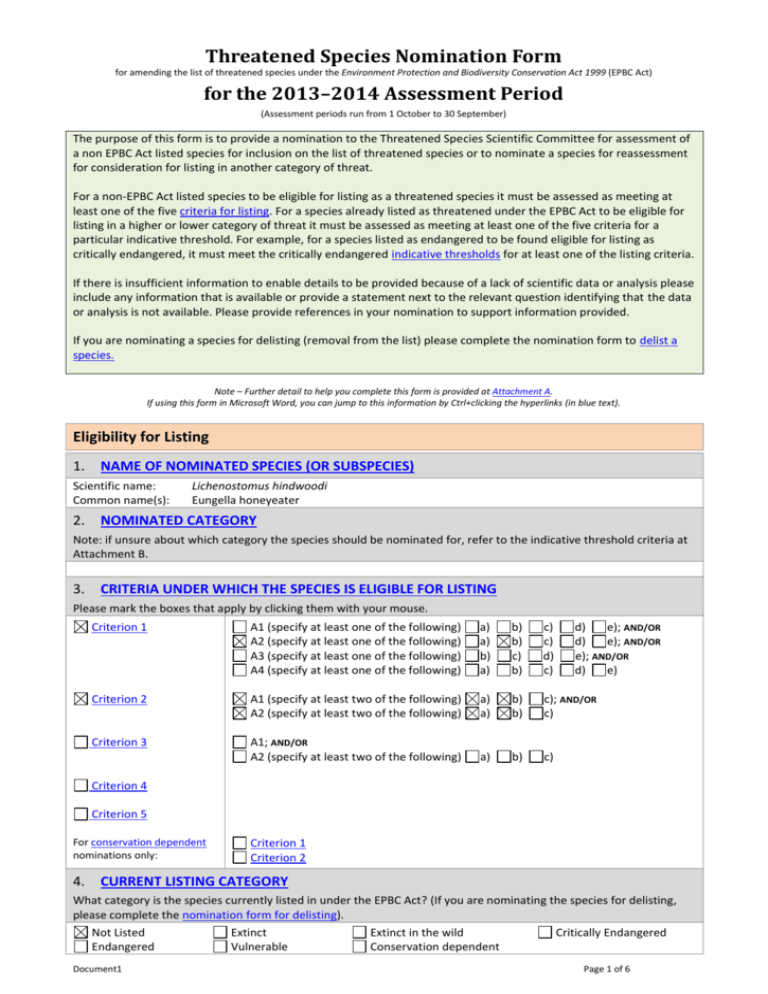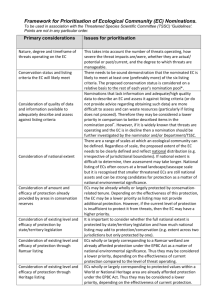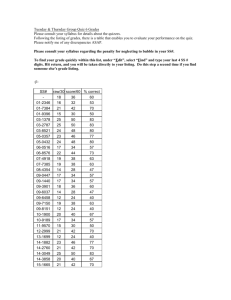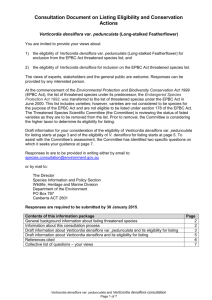Threatened Species Nomination Form
advertisement

Threatened Species Nomination Form for amending the list of threatened species under the Environment Protection and Biodiversity Conservation Act 1999 (EPBC Act) for the 2013–2014 Assessment Period (Assessment periods run from 1 October to 30 September) The purpose of this form is to provide a nomination to the Threatened Species Scientific Committee for assessment of a non EPBC Act listed species for inclusion on the list of threatened species or to nominate a species for reassessment for consideration for listing in another category of threat. For a non-EPBC Act listed species to be eligible for listing as a threatened species it must be assessed as meeting at least one of the five criteria for listing. For a species already listed as threatened under the EPBC Act to be eligible for listing in a higher or lower category of threat it must be assessed as meeting at least one of the five criteria for a particular indicative threshold. For example, for a species listed as endangered to be found eligible for listing as critically endangered, it must meet the critically endangered indicative thresholds for at least one of the listing criteria. If there is insufficient information to enable details to be provided because of a lack of scientific data or analysis please include any information that is available or provide a statement next to the relevant question identifying that the data or analysis is not available. Please provide references in your nomination to support information provided. If you are nominating a species for delisting (removal from the list) please complete the nomination form to delist a species. Note – Further detail to help you complete this form is provided at Attachment A. If using this form in Microsoft Word, you can jump to this information by Ctrl+clicking the hyperlinks (in blue text). Eligibility for Listing 1. NAME OF NOMINATED SPECIES (OR SUBSPECIES) Scientific name: Common name(s): 2. Lichenostomus hindwoodi Eungella honeyeater NOMINATED CATEGORY Note: if unsure about which category the species should be nominated for, refer to the indicative threshold criteria at Attachment B. 3. CRITERIA UNDER WHICH THE SPECIES IS ELIGIBLE FOR LISTING Please mark the boxes that apply by clicking them with your mouse. Criterion 1 A1 (specify at least one of the following) A2 (specify at least one of the following) A3 (specify at least one of the following) A4 (specify at least one of the following) a) a) b) a) b) b) c) b) c) c) d) c) d) e); AND/OR d) e); AND/OR e); AND/OR d) e) Criterion 2 A1 (specify at least two of the following) A2 (specify at least two of the following) a) a) b) b) c); AND/OR c) Criterion 3 A1; AND/OR A2 (specify at least two of the following) a) b) c) Criterion 4 Criterion 5 For conservation dependent nominations only: 4. Criterion 1 Criterion 2 CURRENT LISTING CATEGORY What category is the species currently listed in under the EPBC Act? (If you are nominating the species for delisting, please complete the nomination form for delisting). Not Listed Extinct Extinct in the wild Critically Endangered Endangered Vulnerable Conservation dependent Document1 Page 1 of 6 5. 2013–2014 CONSERVATION THEME: There is no conservation theme for the 2013–2014 Assessment Period – 6. CONSERVATION STATUS What is the species’ current conservation status under State/Territory Government legislation? Does the species have specific protection under other legislation or intergovernmental arrangements? QLD NCA Regulations Near Threatened Species Information 7. TAXONOMY Provide any relevant detail on the species' taxonomy (e.g. naming authority, year and reference; synonyms; Family and Order) and whether or not it is conventionally accepted. Eungella honeyeater (Lichenostomus hindwoodi) 8. DESCRIPTION Provide a description of the species, including size and/or weight, social structure and dispersion (e.g. solitary/ clumped/flocks), and give a brief description of its ecological role (e.g. is it a ‘keystone’ or ‘foundation’ species, or does it play a role in ecological processes such as seed dispersal or pollination). Note: Information on the species’ geographic distribution should be included at Q.21–25, not here. Endemic speciesin Clarke Range west of Mackay. Found in pairs and flocks. Small. Image in attached document. 9. BIOLOGY Provide information on the species' biology, including its life cycle, generation length, reproductive and feeding characteristics and behaviours. Note: Information on the species’ geographic distribution should be included at Q.21–25, and not here. Example headings are provided below Generation Length (defined as (Longevity + Age at sexual maturity) ÷ 2) Not known Movement Limited range in the Clarke ranges. Endemic species. Occupies less than 5,000 sq.km. Reproduction Annual Feeding Insects, lerps, nectar from blossoms. Insects from eucalypt forests adjacent to rainforests 10. HABITAT Describe the species’ habitats and what role they play in the species' life cycle. Include whether or not the species is associated with, or if it relies on, a listed threatened ecological community or listed threatened species? Note: Information on the species’ geographic distribution should be included at Q.21–25, and not here. Feeds on insects & lerps in eucalypt woodland in winter and nests in September in adjoining rainforest. Transfer Information (for up-listing or down-listing of species) Note: If the nomination is to transfer a species between categories please complete questions 15, 16 and 17. If the nomination is for a new listing please proceed to question 18. If the nomination is to delist the species, please use the delisting form. 11. REASON FOR THE NOMINATION FOR CATEGORY CHANGE Please mark the boxes that apply by clicking them with your mouse. What is the reason for the nomination: Genuine change of status Taxonomic change – Document1 ‘split’ New Knowledge newly described Mistake ‘lumped’ Other no longer valid Page 2 of 6 12. INITIAL LISTING Describe the reasons for the species’ initial listing and if available the criteria under which it was formerly considered eligible Not considered before 13. CHANGES IN SITUATION With regard to the listing criteria, how have circumstances changed since the species was listed that now makes it eligible for listing in another category? Threats i.e. logging and mining exploration permits in winter habitat & declining population Population Size 14. NUMBERS What is the total number of mature individuals? How was this figure derived? Identify important populations necessary for the species’ long-term survival and recovery. Total estimated population 2,500 from surveys. Important population in Crediton State Forest. a. b. 15. POPULATION TREND What is the population trend (PAST to CURRENT) for the entire species? Is the population trended increasing or decreasing, or is the population static? If possible, include a percentage change in population size over a 10 year or 3 generation period, whichever is the longer (for example, “this species has shown an 80% decline over 23 years, which is equal to 3 generations”). Please ensure you provide relevant data sources. b. Is this trend likely to continue, or are there any data which indicate that there may be FUTURE changes in population size? Provide relevant data sources. c. Does the species undergo extreme fluctuations in the number of mature individuals? a. Significant decline and still decreasing 20-50% 1990s-2000s. QPWS. See attached document b. Trend will continue as more threatening processes. See attached document. c. No information available. a. 16. PROBABILITY OF EXTINCTION IN THE WILD Has the probability of the species’ extinction in the wild over a particular timeframe been quantified? If so, identify and explain the quantitative measures or models used to generate this probability. Population numbers have dropped by 50% from flocks up to 60 to pairs or individuals now mostly seen. Geographic Distribution 17. GLOBAL DISTRIBUTION Describe the species' known or estimated current and past global distribution (include a map if available). Does the species exist within a threatened ecological community listed under the EPBC Act? Indigenous to Clarke Range only. Not within a threatened ecological community. 18. EXTENT OF OCCURRENCE within Australia NOTE: The distribution of the species within Australia is assessed in two ways, the EXTENT OF OCCURRENCE and the AREA OF OCCUPANCY. The two concepts are closely related, and often confused. Therefore, before you answer this question, please see the definitions and explanatory material in Attachment A. a. What is the CURRENT extent of occurrence (in km2)? Explain how it was calculated and provide relevant data sources. b. Has the extent of occurrence changed over time (PAST to CURRENT)? If so, provide evidence. c. Is the extent of occurrence expected to decline in FUTURE? If so, provide evidence. d. Does the species’ extent of occurrence undergo extreme fluctuations? If so, provide evidence. a. Current extent Clark Range north-east to Cathu State Forest and south to Crediton State Forest, and in Eungella National Park. Document1 Page 3 of 6 19. AREA OF OCCUPANCY NOTE: The distribution of the species within Australia is assessed in two ways, the EXTENT OF OCCURRENCE and the AREA OF OCCUPANCY. The two concepts are closely related, and often confused. Therefore, before you answer this question, please see the definitions and explanatory material in Attachment A. a. What is the CURRENT area of occupancy (in km2)? Explain how it was calculated and provide relevant data sources. b. Has the area of occupancy changed over time (PAST to CURRENT)? If so, provide evidence. c. Is the area of occupancy expected to decline in FUTURE? If so, provide evidence. d. Does the species’ area of occupancy undergo extreme fluctuations? If so, provide evidence. a. Less than 2,000 sq. km. From QLD Parks & Wildlife Service Management Plan for this species. b. Area of Occupancy has remained the same but population has fallen within that accoridng to surveys over thes last decade. c. May decline in the future as more human disturbance in the Eungella rainforest areas next to the national park as more people move in and logging in the species' eucalyptCrediton State Forest habitat has re-commenced under the new state government. Two-thirds of the state forest is covered with mining exploration permits. d. No as far as we know. 20. PRECARIOUSNESS Is the species' geographic distribution severely fragmented, or known to exist at a limited number of locations? Is the area, extent and/or quality of the species' habitat in continuing decline (observed / inferred / projected)? Is the number of locations or subpopulations in continuing decline (observed / inferred / projected)? Are there extreme fluctuations in the number of locations or subpopulations of this species? Please ensure that you provide evidence and appropriate references. a. Only exists in a limted number of locations. Its range is the smallest of any Australian bird species. b. Re-introduction of logging and threat of mining in State forest,and human population growth and more rainforest clearing at Eungella indicate a decline. (observed) c. Eungella honeyeaters at Diggins Road in rainforest are now rarely seen. Numbers are declining at survey areas within Crediton State Forest. d. More like a steadt decline in numbers than fluctuations. a. b. c. d. 21. PROTECTED AREAS Is the species protected within the reserve system (e.g. national parks, Indigenous Protected Areas, or other conservation estates, private land covenants, etc.)? If so, which populations? Which reserves are actively managed for this species? Give details. This species moves seasonally between Crediton State Forest (in winter) - limited protection from a QPWS Management Plan and Eungella Nationa Park - protected. Limited protection in Cathu State Park by the existence of a QPWS Management Plan. Dept. Agriculture Fisheries and Forestry has to notify QPWS of logging permit applications. Threats 22. KNOWN THREATS Identify any KNOWN threats to the species, and state clearly whether these are past, current or future threats. NB – CLIMATE CHANGE AS A THREAT. If climate change is an important threat to the nominated species it is important that you provide referenced information on exactly how climate change might significantly increase the nominated species’ vulnerability to extinction. For guidance refer to the Guidelines for assessing climate change as a threat to native species (Attachment B; Part B2). Logging permits will now be issued in Crediton Cathu and Mia Mia State Forests. Mining exploration permits cover two thirds of Crediton State Forests. The rest of Crediton SF was classified as a Forest reserve in the last few years but this is likely to be revoked soon by the new QLD government so the whole forest will be under threat of logging. 23. POTENTIAL THREATS Identify any POTENTIAL threats to the species. Loss of suitable habitat and forage areas as selective clearing for logging continues in the State forests. Granting of mining leases in Crediton State Forest. Continued increase in population at Eungella where many miners are buying and clearing small acreage lots. Longer droughts under climate change which reduce food sources. 24. THREAT ABATEMENT Give an overview of recovery and threat abatement/mitigation actions that are underway and/or proposed. The Mackay Highlands were to undergo a process of World Heritage nomination if the State Forests could be included in the National Parks system. With the new QLD government this process has ceased. No recovery or mitigation efforts Document1 Page 4 of 6 for this species are underway other than recommendations by QPWS to mitigate damage from the logging applications. Surveys and Monitoring 25. DISTINCTIVENESS Give details of the distinctiveness of the species. Is this species taxonomically distinct? Taxonomic distinctiveness is a measure of how unique a species is relative to other species. How distinct is this species in its appearance from other species? How likely is it to be misidentified? It is taxonomically distinct and was only indentified in the 1980s. It is distinctly different in appearance but is usually shy and identified by its distinctive call. 26. DETECTABILITY Provide information on how easy the species is to detect and the ease of which it has been/can be surveyed. If possible, provide information on when and how surveys should be conducted, for example: Recommended methods Season, time of day, weather conditions Length, intensity and pattern of search effort Limitations and whether or not the method is accepted by experts Survey-effort guide Methods for detecting the species. QPWS:i) Observations of flocks of L. hindwoodi feeding in adjacent wucalypt woodlands in the dry season prior to and during the breeding period (1997 to present). ii) Long term surveys along rainforest transects of up to 17km long (1981 to present). Birds Australia: 15 sites in three categories 1. rainforest 2. lightly grazed 3. heavily grazed late 2006-late 2007. 20 minute 2 ha survey sun up to sunset. 27. SURVEYS Provide information on survey effort to date, and any ongoing/proposed monitoring programs. See information in 30. MacBOCA conducts informal roadsite surveys in known habitat spots each year and takes visitors informally. Conservation Dependent Considerations Note: Only complete this section if nominating for consideration under the conservation dependent category, or if nominating a fish (or harvested marine species) with a management plan. Answer either Q.32 OR Q.33, whichever is more appropriate. 28. CONSERVATION PROGRAM (if species is a fish or harvested marine species, see Q.33 first) a) Give details of the conservation program for which this species is a focus. b) Provide details of how the species would become vulnerable, endangered or critically endangered should the program cease. 29. FISH MANAGEMENT PLANS a) Give details of the plan of management that focuses on the fish. b) Provide details of how the plan provides for management actions necessary to stop the decline of and support the recovery of the species, so that its chances of long term survival in nature are maximised. c) Explain the effect on the fish if the plan of management ceased 30. MANAGEMENT PLAN’S LEGISLATIVE BASIS Is the plan of management (or some component/s of it) in force under Commonwealth or State/Territory law? If so, provide details. Document1 Page 5 of 6 Indigenous Values 31. INDIGENOUS CULTURAL SIGNIFICANCE Is the species known to have cultural significance for Indigenous groups within Australia? If so, to which groups? Provide information on the nature of this significance if publicly available. No Reviewers and Further Information 32. REVIEWER(S) Has this nomination been peer-reviewed? Have relevant experts been consulted on this nomination? If so, please include their names, current professional positions and contact details. Discussed with Andrew Silcocks Birdlife Australia. Atlas Project manager, Ph:03 9347 0757 , andrew.silcocks@birdlife.org.au 33. FURTHER INFORMATION Identify relevant studies or management documentation that might relate to the species (e.g. research projects, national park management plans, recovery plans, conservation plans, threat abatement plans, etc.). 1. QPWS Management Plan for the Eungella honeyeater. 2. Chris Sanderson et al. Bird Atlassing in regions: Mackay Whitsunday region - Birdlife of the rainforest and adjacent woodland, 2007. 3. Mackay Highlands: Planning for the Future. http://www.derm.qld.gov.au/parks_and_forests/managing_parks_and_forests/management_plans_and_strategies/ma ckay_highlands.html 34. REFERENCE LIST Please list key references/documentation you have referred to in your nomination. Please see references in attached documents 35. APPENDIX Please place here any figures, tables or maps that you have referred to within your nomination. Alternatively, you can provide them as an attachment. Please see attached document 36. DECLARATION I declare that, to the best of my knowledge, the information in this nomination and its attachments is true and correct. Document1 Page 6 of 6






